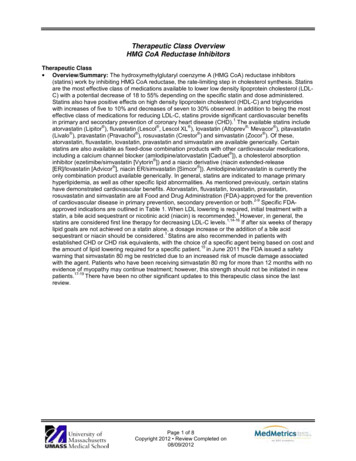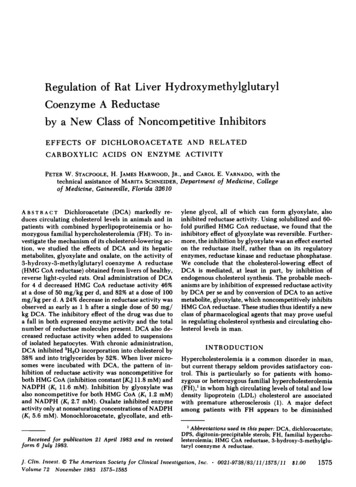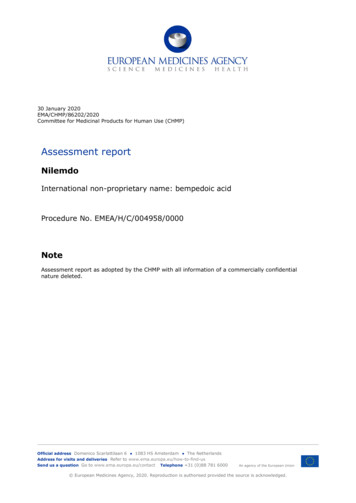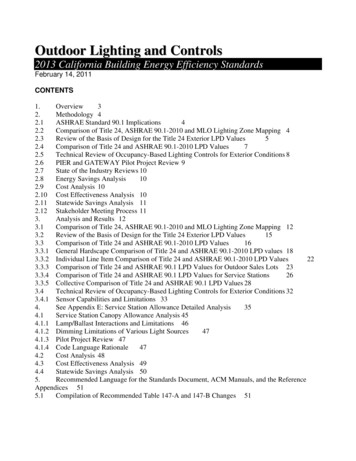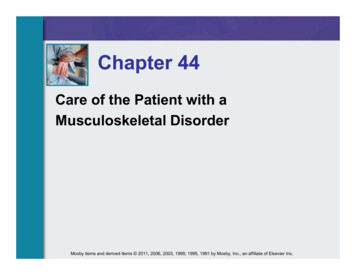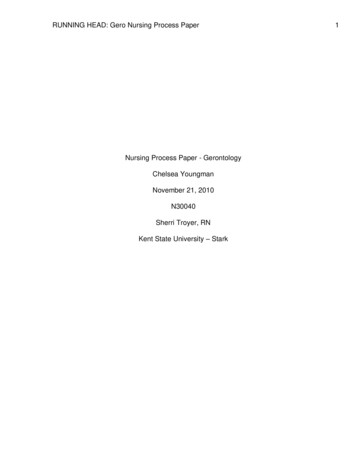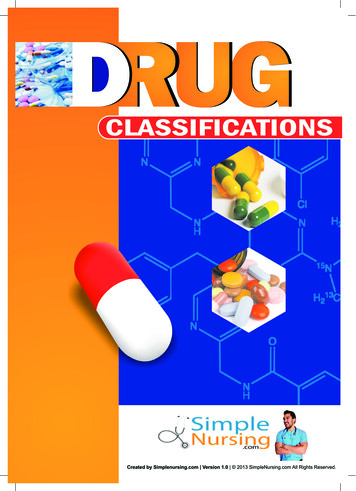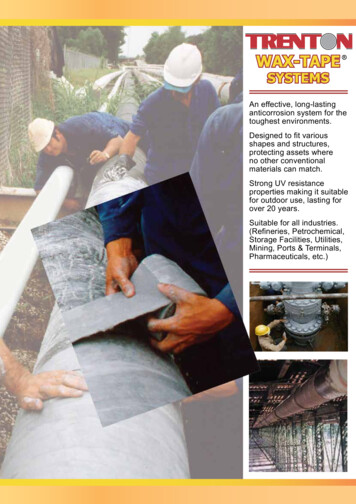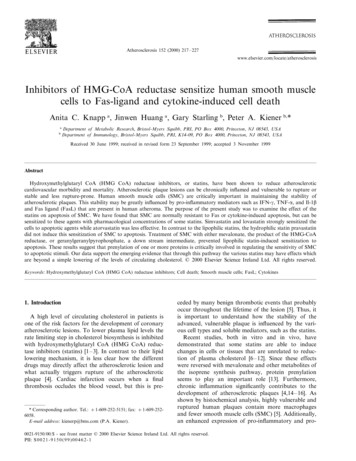
Transcription
Atherosclerosis 152 (2000) 217 – rs of HMG-CoA reductase sensitize human smooth musclecells to Fas-ligand and cytokine-induced cell deathAnita C. Knapp a, Jinwen Huang a, Gary Starling b, Peter A. Kiener b,*abDepartment of Metabolic Research, Bristol-Myers Squibb, PRI, PO Box 4000, Princeton, NJ 08543, USADepartment of Immunology, Bristol-Myers Squibb, PRI, K14 -09, PO Box 4000, Princeton, NJ 08543, USAReceived 30 June 1999; received in revised form 23 September 1999; accepted 3 November 1999AbstractHydroxymethylglutaryl CoA (HMG CoA) reductase inhibitors, or statins, have been shown to reduce atheroscleroticcardiovascular morbidity and mortality. Atherosclerotic plaque lesions can be chronically inflamed and vulnerable to rupture orstable and less rupture-prone. Human smooth muscle cells (SMC) are critically important in maintaining the stability ofatherosclerotic plaques. This stability may be greatly influenced by pro-inflammatory mediators such as IFN-g, TNF-a, and Il-1band Fas ligand (FasL) that are present in human atheroma. The purpose of the present study was to examine the effect of thestatins on apoptosis of SMC. We have found that SMC are normally resistant to Fas or cytokine-induced apoptosis, but can besensitized to these agents with pharmacological concentrations of some statins. Simvastatin and lovastatin strongly sensitized thecells to apoptotic agents while atorvastatin was less effective. In contrast to the lipophilic statins, the hydrophilic statin pravastatindid not induce this sensitization of SMC to apoptosis. Treatment of SMC with either mevalonate, the product of the HMG-CoAreductase, or geranylgeranylpyrophosphate, a down stream intermediate, prevented lipophilic statin-induced sensitization toapoptosis. These results suggest that prenylation of one or more proteins is critically involved in regulating the sensitivity of SMCto apoptotic stimuli. Our data support the emerging evidence that through this pathway the various statins may have effects whichare beyond a simple lowering of the levels of circulating cholesterol. 2000 Elsevier Science Ireland Ltd. All rights reserved.Keywords: Hydroxymethylglutaryl CoA (HMG CoA) reductase inhibitors; Cell death; Smooth muscle cells; FasL; Cytokines1. IntroductionA high level of circulating cholesterol in patients isone of the risk factors for the development of coronaryatherosclerotic lesions. To lower plasma lipid levels therate limiting step in cholesterol biosynthesis is inhibitedwith hydroxymethylglutaryl CoA (HMG CoA) reductase inhibitors (statins) [1 – 3]. In contrast to their lipidlowering mechanism, it is less clear how the differentdrugs may directly affect the atherosclerotic lesion andwhat actually triggers rupture of the atheroscleroticplaque [4]. Cardiac infarction occurs when a finalthrombosis occludes the blood vessel, but this is pre-* Corresponding author. Tel.: 1-609-252-5151; fax: 1-609-2526058.E-mail address: kienerp@bms.com (P.A. Kiener).ceded by many benign thrombotic events that probablyoccur throughout the lifetime of the lesion [5]. Thus, itis important to understand how the stability of theadvanced, vulnerable plaque is influenced by the various cell types and soluble mediators, such as the statins.Recent studies, both in vitro and in vivo, havedemonstrated that some statins are able to inducechanges in cells or tissues that are unrelated to reduction of plasma cholesterol [6–12]. Since these effectswere reversed with mevalonate and other metabolites ofthe isoprene synthesis pathway, protein prenylationseems to play an important role [13]. Furthermore,chronic inflammation significantly contributes to thedevelopment of atherosclerotic plaques [4,14–16]. Asshown by histochemical analysis, highly vulnerable andruptured human plaques contain more macrophagesand fewer smooth muscle cells (SMC) [5]. Additionally,an enhanced expression of pro-inflammatory and pro-0021-9150/00/ - see front matter 2000 Elsevier Science Ireland Ltd. All rights reserved.PII: S 0 0 2 1 - 9 1 5 0 ( 9 9 ) 0 0 4 6 2 - 1
218A.C. Knapp et al. / Atherosclerosis 152 (2000) 217–227apoptotic mediators correlates with plaque instability[17,18]. These pro-inflammatory mediators are able toinduce apoptosis of SMC in vitro [19], and SMC in theadvanced plaque may undergo increased programmedcell death. One pathway that appears to be involved inapoptosis is the Fas (CD95 or Apo-1)-FasL system. Fasis a type I membrane protein belonging to the TNFreceptor family and its receptor mediates a death signalafter binding to its ligand, FasL. Fas expression hasbeen found in the human atherosclerotic intima [20],indeed, most of the cells in the advanced lesion havebeen found to express Fas [21]. In addition, activatedT-cells and monocytes are major sources for both FasLand cytokines, and these cells are present at sites ofplaque rupture in human atheroma [14]. Overall, thefindings from many investigators indicate that the dynamics of an atherosclerotic plaque are influenced bythe different proinflammatory mediators, such as IFNg, TNF-a, Il-1b and FasL, that are present in the localmicroenvironment [14].In the advanced, highly inflamed plaque, many different cell types, including SMC and macrophages, canundergo apoptosis. However, there is only a rudimentary understanding how plaque stability is affectedthrough apoptosis of the various cells. Although in thehuman atherosclerotic plaque, both necrosis and apoptosis have been localized to sites of plaque rupture [22],abundant evidence suggests that SMC primarily die byapoptosis [23]. For example, in contrast to SMC fromnormal vessels, cells derived from human atherosclerotic plaques proliferate more slowly, undergo fewerproliferative cycles, and are more susceptible to spontaneous apoptotic cell death [23,24]. In addition, it hasbeen shown that intimal lesions contain more TUNELpositive SMC than the non-atherosclerotic arterial intima [25]. Because the production of plaque stabilizingextracellular matrix proteins in the advanced lesion isconsidered to be beneficial and is primarily dependenton SMC in the intima, depletion of SMC in the advanced plaque is thought to enhance plaque thinning[5,21,23–28]. However, SMC may play different rolesin different pathological contexts. Overall, the pro-inflammatory environment of a plaque may increase thesusceptibility of SMC to cell death, and the concomitant loss of synthesis of extracellular matrix proteinswould then lead to an increase in plaque instability[5,29].The effects of the different statins in the pro-inflammatory or pro-apoptotic environment of the plaque isnot well understood, but could have important implications in cardiovascular disease. In this report wedemonstrate that lipophilic statins at in vitro concentrations that are potentially pharmacologically relevant,directly sensitize SMC to both FasL and cytokine induced apoptosis.2. Experimental procedures2.1. ReagentsSimvastatin, lovastatin and pravastatin were synthesized by Bristol-Myers Squibb and atorvastatin was agenerous gift from Parke-Davis. Simvastatin, lovastatinand mevalonate were activated to their active open-ringforms as described [30]. Geranylgeranylpyrophosphateand farnesylpyrophosphate were obtained from AlexisBiochemicals and were used at 20 mmol/l. Recombinantsoluble human Fas-ligand (sFasL) and human Fas-Igfusion proteins were produced and purified as describedpreviously [31]. The sFasL fusion protein contains theextracellular domain of human FasL and the extracellular region of mouse CD8. Analysis of the purifiedfusion protein by gel filtration revealed that it is amixture of dimers and trimers. As such this protein veryeffectively stimulates apoptosis in Jurkat cells and additional crosslinking of the fusion protein with an antimouse CD8 mAb did not further enhance activity.Recombinant human TNF-a, IFN-g, and Il-1b wereobtained from R&D Systems. sFasL was used at 100ng/ml and Fas-Ig at 50 mg/ml. To relate our results toa previous study on apoptosis of SMC [32], the cytokines were used at 400 U/ml for TNF-a and IFN-g, and100 U/ml for Il-1b. In experiments where all threecytokines were used together at these concentrations,this is called the ‘cytokine cocktail’. Alamar blue waspurchased from Biosource, and the ApopTag Directfluorescein in situ apoptosis detection kit was obtainedfrom Oncor.2.2. Cell culture and 6iabilityHuman aortic smooth muscle cells and human coronary artery endothelial cells (EC) were obtained fromClonetics and were cultured in growth medium fromClonetics with 10% FBS. Cells were seeded at 80%confluency and grown to confluency over a period of 5days. The cells were not used beyond seven passages.SMC were plated in 96-well plates and cultured withthe additions as noted in the text. At the end of thetreatment, the medium was removed and replaced withfresh medium including 10% Alamar blue. The cellswere then incubated for a further 3–4 h and theabsorbance was measured at two wavelengths, 570 and590 nm, in an ELISA plate reader (Molecular DevicesSpectra Max 340) and the OD value at 590 nm wassubtracted from that at 570 nm. Samples were assayedwith eight replicates from each treatment, and the meanOD value calculated.After reaching confluency, the SMC were incubatedwith statins for 24 h. These were then followed by theindicated concentration of cytokines either alone or incombination for an additional 48–72 h. Alternatively,
A.C. Knapp et al. / Atherosclerosis 152 (2000) 217–227statin treated cells were incubated with sFasL (100ng/ml) for 24 h. When added, statins were presentthroughout the subsequent culture of the cells. Afterthese incubations, the cells were harvested and viabilitywas determined as outlined. Where appropriate, Fas-Ig,mevalonate (500 mmol/l), farnesylpyrophosphate (20mmol/l) or geranylgeranylpyrophosphate (20 mmol/l),were added to the cultures at the same time as additionof the statins.2.3. Staining of cells for apoptosis: TUNEL analysisAfter the specified treatments, SMC were harvestedby collecting both the floating cells by centrifugationand the adherent cells by trypsinization and the populations pooled. Cells were mounted on coverslips, fixedwith formalin and the DNA labeled with fluoresceinusing terminal deoxyribonucleotide transferase according to the manufacturer’s protocol. Per image, 100nuclei were counted, and the percentage of TUNELpositive cells to total number of cells was determined.For each treatment, four different images were analyzed. Error bars indicate the standard deviations.Fig. 1. Effect of sFasL or cytokines on the morphology of statintreated SMC. SMC were treated with the cytokine cocktail of TNF-a,IFN-g, and Il-1b (panels b, e, h) or with 100 ng/ml sFasL (panels c,f, i) in the absence (panels a–c) or presence of 3 mmol/l simvastatin(panels d – f) or 20 mmol/l pravastatin (panels g–i). Cells were pretreated with statins for 24 h and then stimulated with the cytokinecocktail or sFasL prior to analysis by light microscopy; photomicrographs are original magnification 400.2192.4. Analysis by staining with propidium iodideSMC were harvested from the tissue culture plates byadding EDTA to the whole culture to a final concentration of 5 mmol/l; plates were incubated for 5 min at37 C to allow full detachment of SMC. The cells andmedia were removed, the plates were washed once withRPMI containing 5 mmol/l EDTA and this wash wascombined with the original media. Cells were spundown and then permeabilized with buffer containingsodium citrate (0.3%), Triton X-100 (0.01%) and propidium iodide (50 mg/ml). The samples were then analyzed by FACS on a Becton Dickinson FACScan.3. Results3.1. Morphological changes in statin-sensitized SMCindicati6e of apoptosis upon treatment with sFasL orcytokinesAn earlier report on SMC showed that statins at highconcentration could induce apoptosis [33], hence initialexperiments were carried out to determine whether thestatins at low micromolar concentrations would inducevisible changes of SMC in culture. Furthermore, sincelipophilic statins have been shown to inhibit the proliferation of various types of exponentially growing cells[10,34,35], all experiments were performed with confluent cells. Incubation of SMC with simvastatin (3 mmol/l) for 48 or 72 h, induced a slight increase in thenumber of rounded cells that were detached from thesubstratum (Fig. 1d) but most of the cells were stilladherent. Incubation of SMC without statin pre-treatment, but with a cocktail of IFN-g, TNF-a, and Il-1bfor 72 h (Fig. 1b), or with sFasL for 24 h (Fig. 1c), didnot induce any significant change in the morphology ofthe cells, in agreement with an earlier report [36]. Incontrast, preincubation of the SMC with simvastatin (3mmol/l) for 24 h followed by stimulation of the cellswith the cytokine cocktail for 72 h (Fig. 1e) or sFasLfor 24 h (Fig. 1f) resulted in the detachment of manycells from the substratum and prominent shrinkage ofthe SMC, indicative of cells undergoing apoptosis. Similar changes were seen upon treatment of SMC withlovastatin (3 mmol/l) and atorvastatin (3 mmol/l), (datanot shown). In contrast, pravastatin (20 mmol/l) had noeffect on its own (Fig. 1g) and did not sensitize SMC tocytokines (Fig. 1h) or sFasL (Fig. 1i).3.2. Lipophilic statins sensitize SMC to cytokine andsFasL induced apoptosisThe response of SMC to sFasL following statintreatment strongly suggested that the cells were undergoing apoptosis. To examine this in more detail, cells
220A.C. Knapp et al. / Atherosclerosis 152 (2000) 217–227Fig. 2. Induction of TUNEL staining in lipophilic statin-treated cells following stimulation with sFasL or cytokines. Cells were seeded at 96 000cells/well in six-well plates and allowed to reach confluency. They were then treated with 3 mmol/l simvastatin, 6 mmol/l atorvastatin, or 5 mmol/lpravastatin for 24 h, followed by stimulation with sFasL for a further 24 h. Alternative
Hydroxymethylglutaryl CoA (HMG CoA) reductase inhibitors, or statins, have been shown to reduce atherosclerotic cardiovascular morbidity and mortality. Atherosclerotic plaque lesions can be chronically inflamed and vulnerable to rupture or stable and less rupture-prone. Human smooth muscle cells (SMC) are critically important in maintaining the stability of atherosclerotic plaques. This .
